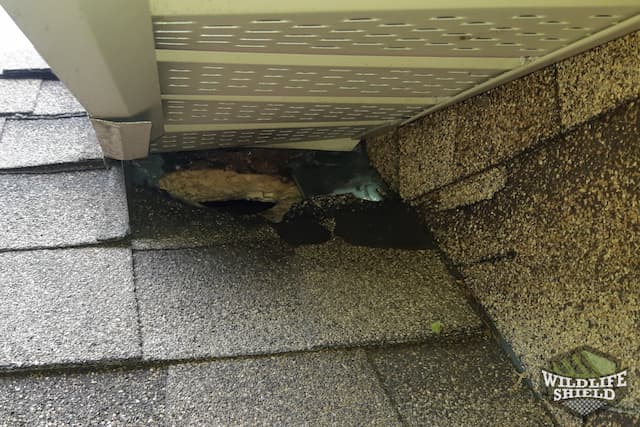The following case study details a squirrel removal and wildlife-proofing job in Guelph, Ontario. Squirrels broke into the attic of this century home by chewing a hole in the roof, then built a nest in the attic’s insulation. To remove them safely, a technician installed a one-way door to the entry point then sealed all other potential entry points with steel mesh. The squirrels have since found another place to live. If you are dealing with a squirrel problem, give Wildlife Removal Guelph a call.
Inspection
The homeowners in this case first called Wildlife Removal Guelph when they noticed that an animal had chewed a hole in their ceiling. Leaves and twigs were falling out of the hole, indicating that a squirrel might have built a nest in the attic. They could also hear noises coming from the attic during the day, which is a common sign of a squirrel infestation. Squirrels like to nest in attics because they are warm, above ground, and relatively safe from predators.
The day after the owners called, a technician came to investigate. No matter the situation, the professionals on the Wildlife Removal team conduct detailed inspections to find the root causes of the issue as well as any other weaknesses that can be addressed. This allows us to provide solutions that last.
The home in this case was at least one hundred years old, rendering it especially susceptible to the invasion of squirrels and other wildlife. Older neighbourhoods have mature trees and flora, which attract these animals. The structures of the houses have also had enough time to deteriorate, creating openings for wildlife to enter. Here, the technician began his investigation on the roof, which is where squirrels most commonly break-in.
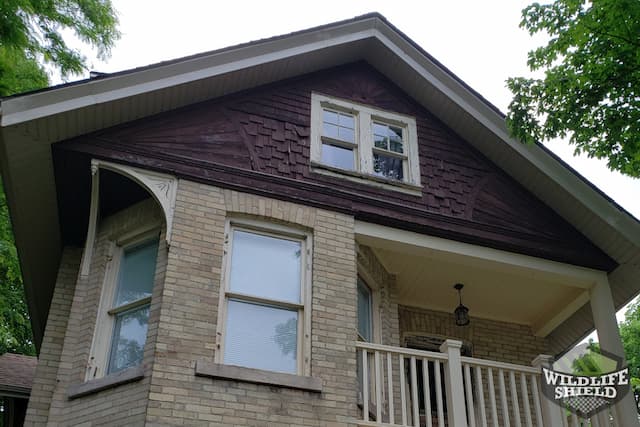
On the roof, the technician looked for signs of squirrel activity, such as droppings, chew marks, and scratch marks. A large hole was found in the roof beneath the soffits of the upper level. A squirrel had most likely torn at the shingles, then chewed its way through the framing of the house. While this is an unusual point of entry, squirrels can chew through the toughest materials. While examining the rest of the roof, the technician also found a hole in the corner of a roof vent. Like the roof, a squirrel likely chewed its way through the roof vent to reach the attic.
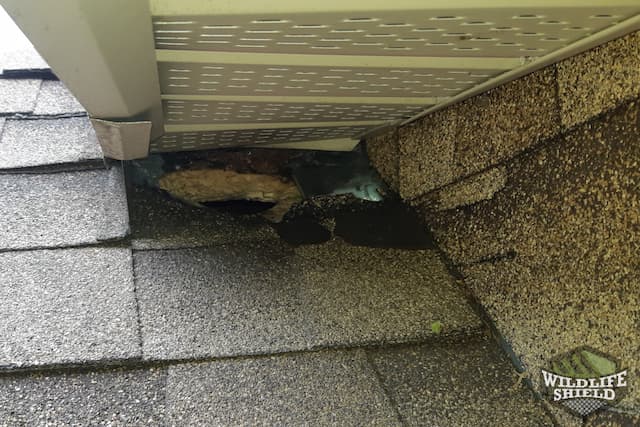
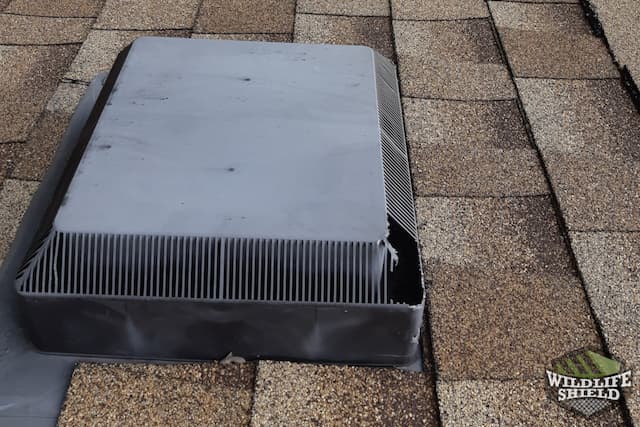
Given the state of the covid-19 pandemic, the homeowners requested that the technician remain outdoors. Our experts always offer a complete inspection of the interior, but we are respectful of our customers’ concerns and take their safety very seriously. The homeowners instead presented the technician with some images of the hole in the ceiling. Given the nesting material in the hole and the damage on the exterior, it was clear that a squirrel was nesting in the attic.
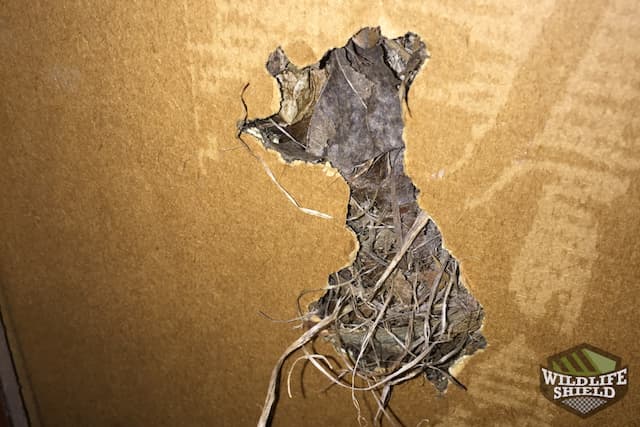
Removal and Exclusion
Following the inspection, the technician recommended installing a one-way door to the entry point in the roof. This would let the squirrel living in the attic out safely while preventing its re-entry. To ensure that the squirrel would not find another way in, the technician on-site also recommended covering the roof vents and roof-soffit intersections with an impenetrable mesh. The homeowner in this case agreed to go ahead with the work and the technician got started right away.
First, the technician covered the roof vents with galvanized steel mesh and screwed the material right into the roof. Galvanized steel is flexible, durable, and strong enough to withstand the chewing and tearing of squirrels and other animals. Next, the technician covered a part of the roof similar to the area that had been chewed through. The additional mesh was screwed into a soffit where it met the roof below to ensure that no more animals would take advantage of this area. Roof-soffit intersections are vulnerable to squirrels and raccoons because they can stand on the roof below while pushing and chewing on the soffit above. It is important to strengthen these areas, especially in older neighbourhoods like this one where there are many animals around.
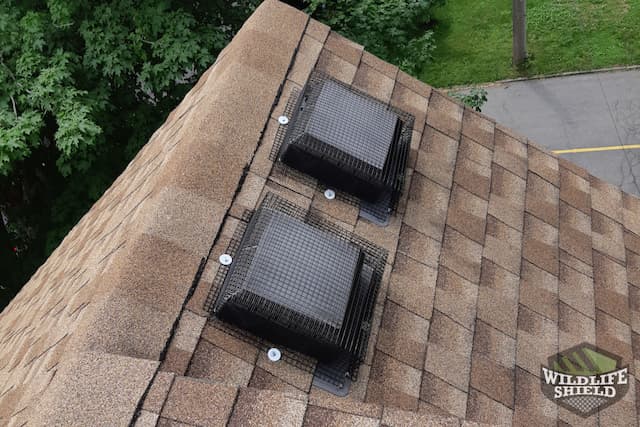
Finally, the wildlife removal technician installed a one-way door to the hole in the roof. This door consists of a mesh tube and flap that swings outward, letting the squirrel out but preventing it from getting back in. This would not harm the squirrel. Once out, it would simply find another place to nest. Squirrels often keep more than one nest at a time.
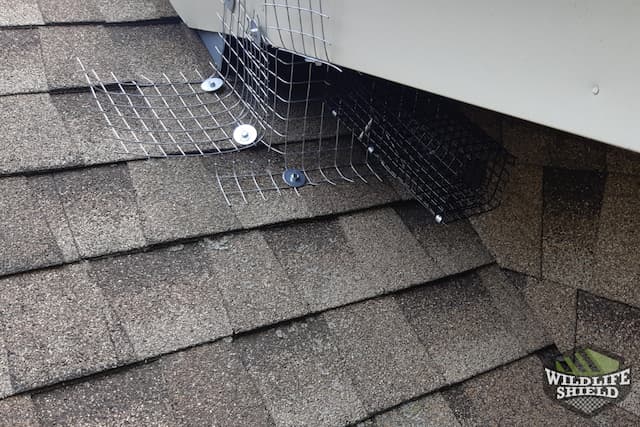
A few weeks later, the homeowners called back to say that they were no longer hearing noises in the attic. The squirrel had left the attic and was unable to get back inside. A technician then returned to the property to remove the one-way door and replace it with mesh.
Conclusion
Squirrels will take advantage of any weaknesses they find on the roof to reach the attic inside. These are small rodents that can chew right through the plastic, wood, aluminum, and vinyl. Once indoors, they will cause a tremendous amount of damage, chewing on electrical wires and contaminating the insulation with feces and disease. It is important that you maintain your roof and wildlife-proof it so that no animals reach the attic. If you are interested in wildlife-proofing services, reach out to Wildlife Removal Guelph. Our exclusion services come with a 2-year warranty.
